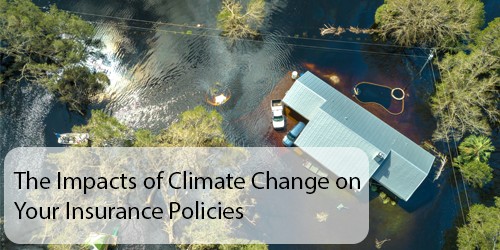Insurance and Climate Change: What’s the Impact?
The relationship between insurance and climate change is becoming increasingly complex and critical as the effects of global warming intensify. For decades, the insurance industry has served as a financial safety net, helping individuals, businesses, and communities recover from unforeseen disasters. However, with the growing frequency and severity of climate-related events such as hurricanes, wildfires, floods, and droughts, insurers are facing unprecedented challenges. These environmental shifts are reshaping risk assessments, policy pricing, and the very sustainability of insurance models, making climate change not just an environmental concern but a fundamental business issue for the industry.
At its core, insurance is about managing risk—spreading the potential cost of loss among many to protect the few who experience it. Traditionally, insurers have relied on historical data and actuarial models to predict future losses and set premiums accordingly. Yet climate change is disrupting this approach by introducing new variables and uncertainty into those calculations. Weather patterns are becoming less predictable, and events that were once considered rare are now occurring with alarming regularity. For example, what used to be a once-in-a-century flood might now strike every few decades or even years in some regions. This shift means past data may no longer provide a reliable guide to future risks, challenging insurers to rethink how they evaluate and price policies.
One of the most immediate impacts of climate change on insurance is the rise in claims from natural disasters. Hurricanes with stronger winds, extended wildfire seasons fueled by hotter temperatures and drought, and heavier rainfall causing widespread flooding all contribute to more frequent and costly claims. In recent years, catastrophic events like Hurricane Katrina, the California wildfires, and severe flooding in Europe have resulted in billions of dollars in insured losses. For insurers, this spike in payouts puts significant strain on their financial reserves, often leading to increased premiums for policyholders. Homeowners in high-risk areas, such as coastal regions or wildfire-prone zones, are feeling this impact most acutely, with some even facing difficulties finding affordable coverage.
Moreover, the long-term sustainability of the insurance business model is being called into question. As losses mount, insurers must balance the need to remain solvent with the societal imperative to provide accessible coverage. In some cases, insurers have withdrawn from certain markets altogether, unwilling to take on what they perceive as untenable risks. This withdrawal can leave communities vulnerable and undermine economic stability, especially in regions where government-backed insurance programs are limited or nonexistent. The insurance industry, therefore, finds itself at a crossroads: how to adapt to a climate-altered world while continuing to fulfill its essential role.
In response, insurers are becoming more proactive and innovative in managing climate-related risks. Advanced technology and data analytics now allow companies to incorporate real-time environmental data, satellite imagery, and climate models into their risk assessments. This evolution helps create more dynamic and accurate pricing structures, reflecting the true level of risk posed by climate change. For instance, parametric insurance products are emerging as a promising solution, where payouts are triggered automatically based on specific environmental metrics, such as wind speed or rainfall amounts, rather than on lengthy claims investigations. This innovation can speed up recovery efforts and provide policyholders with greater certainty during chaotic events.
Beyond pricing and claims, the insurance sector is playing a vital role in promoting climate resilience and sustainability. Many insurers are incorporating environmental, social, and governance (ESG) criteria into their underwriting decisions, favoring businesses and projects that demonstrate climate responsibility. By influencing capital flows, insurance companies can encourage investments in renewable energy, energy-efficient buildings, and infrastructure designed to withstand extreme weather. For example, insurers might offer premium discounts to homeowners who retrofit their homes with fire-resistant materials or flood defenses, thereby reducing potential losses and enhancing community resilience.
The intersection of climate change and insurance also raises important questions about social equity. Vulnerable populations—often those with fewer resources—are disproportionately affected by climate disasters and may struggle to secure adequate insurance coverage. This disparity highlights the need for inclusive insurance solutions that consider affordability and accessibility alongside risk. Some governments and nonprofits are stepping in to fill these gaps with subsidized insurance programs or public-private partnerships aimed at expanding coverage. However, the challenge remains to create systems that protect all citizens fairly without encouraging risky behavior or placing unsustainable burdens on insurers.
Looking ahead, the insurance industry’s response to climate change will likely become a bellwether for broader economic adaptation to environmental challenges. As climate science improves and data becomes more granular, insurers will have better tools to forecast risks and innovate new products. However, success depends not only on technology but also on collaboration among insurers, governments, scientists, and communities. Coordinated efforts to improve risk mapping, disaster preparedness, and policy frameworks will be crucial in building a more resilient insurance ecosystem.
In conclusion, climate change is reshaping the insurance landscape in profound ways, challenging traditional models and demanding new approaches. The increase in extreme weather events has raised the stakes for insurers, pushing them to evolve from reactive payers of claims to proactive partners in risk management and climate resilience. While this transition is complex and fraught with challenges, it also presents an opportunity for the industry to lead in crafting solutions that safeguard both the economy and society in an era of environmental uncertainty. Ultimately, the impact of climate change on insurance underscores a broader truth: adapting to our changing world requires innovation, cooperation, and a commitment to sustainable practices that protect us all.







